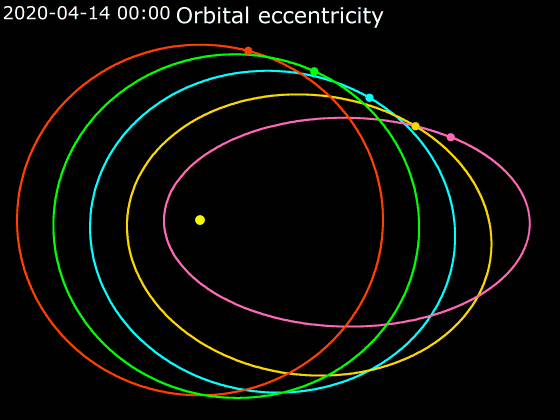Earth is not just habitable, it’s unusually habitable. It’s rather wet for a planet so close to its Sun, it’s geologically active, and it has a stable orbit, all of which are necessary for life as we know it. But there are also secondary advantages, such as not being constantly bombarded by large asteroids, and having a rotational axis that is fairly stable. This is due in part thanks to the planet Jupiter. The giant planet has helped clear the solar system of asteroid debris and may have helped stabilize the orbits of the inner planets. So life is good. But a new study shows that if Jupiter had a different orbit, life could be even better.
The study looked at the way Jupiter affects Earth’s orbit and axial tilt over time. Both of these are important factors in our weather and climate. For example, Earth has a very circular orbit. In mathematical terms, the shape of an orbit is measured by its eccentricity. At e = 0, the orbit is a perfect circle, and the more elliptical an orbit is, the closer e gets to 1. Earth’s orbit has an e = 0.017. This means Earth is slightly closer to the Sun for a bit less than half the year, and slightly farther away for a bit more than half. This is because the Earth moves slightly faster in its orbit when closer to the Sun rather than farther.

At this point, astute readers will be eager to point out that this eccentricity is not why we have seasons, and they’d be mostly right. Our regular seasons are caused by the axial tilt of the Earth, which is currently about 23.4 degrees. Because of this tilt, the Sun is higher during the Summer, and lower in the sky during Winter. And, of course, when it’s Summer in the Northern Hemisphere, it’s Winter in the Southern Hemisphere.
Interestingly, for the Northern Hemisphere, it is Summer when the Earth is a bit farther from the Sun, and that means Northern Summers are just slightly longer than Southern Summers. Since more of the land mass on Earth is in the Northern Hemisphere, that means Earth is a bit more habitable than it would be if we had a circular orbit. It doesn’t affect our daily lives, but it does come into play on geological scales.

Over time the axial tilt of Earth changes slightly, giving more extreme or mild Winters. Earth’s axis also precesses over time, meaning that its orientation relative to the elliptical shape of Earth’s orbit also shifts. All of these factors underly what is known as the Milankovitch cycle. This is a measure of how much overall heat Earth’s terrestrial surface receives, known as insolation. It varies over thousands of years. Twelve thousand years ago, at the dawn of human civilization, insulation was very high, giving us a particularly pleasant world. Currently, it’s somewhat lower, and without the effects of global warming, we would be in a cool period.

Part of the Milankovitch cycle is due to the slight gravitational tug of Jupiter. But since Jupiter also has a circular orbit (e = 0.048), this isn’t a significant factor. In this recent study, the team created simulated solar systems where Jupiter’s orbit had a higher eccentricity. They thought a more eccentric Jupiter would make Earth less habitable, but they were surprised to find it actually made things better. With an increased gravitational effect from Jupiter, the Earth would have better insolation over its surface, so that even more of Earth’s land masses would be within a temperate range.
This has big implications for potentially habitable worlds in other star systems. Although we tend to focus on whether a world is within the habitable zone, that’s only the first requirement for a truly habitable world. Other factors such as insolation depend on the presence of other planets in the system. There’s a gravitational dance between worlds that can make or break a planet’s chances for life.
Reference: Vervoort, Pam, et al. “System Architecture and Planetary Obliquity: Implications for Long-Term Habitability.” The Astronomical Journal 164.4 (2022): 130.

